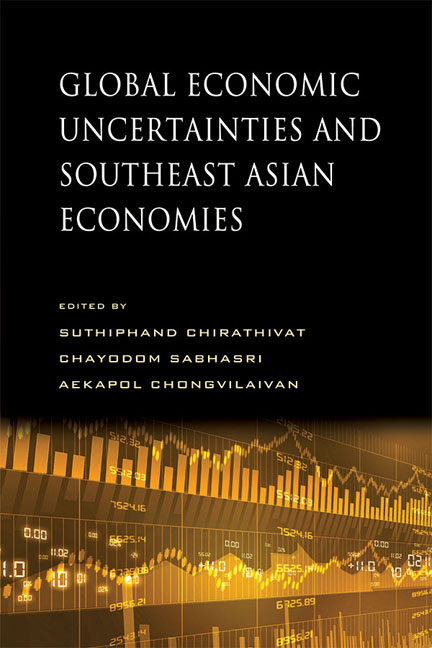Book contents
- Frontmatter
- Contents
- Preface
- Contributors
- 1 Challenges Facing a Globally Connected ASEAN
- 2 Fragile Balance of Payment in Indonesia under Global Economic Uncertainties
- 3 Malaysia in the Midst of Global Economic Uncertainties
- 4 Singapore: Reinventing Itself amid Global Economic Uncertainties
- 5 Thailand: Dependency or Diversification?
- 6 Vietnam's Economic Experience since WTO Accession
- 7 Global Economic Imbalances and Reform Policy: Evidence from Asian Economies
- 8 Foreign Exchange Rate Adjustment Policies in Asia
- 9 Monetary and Financial Architectures for ASEAN+
- 10 Global Uncertainties: Implications for the ASEAN Community
- Index
7 - Global Economic Imbalances and Reform Policy: Evidence from Asian Economies
Published online by Cambridge University Press: 22 July 2017
- Frontmatter
- Contents
- Preface
- Contributors
- 1 Challenges Facing a Globally Connected ASEAN
- 2 Fragile Balance of Payment in Indonesia under Global Economic Uncertainties
- 3 Malaysia in the Midst of Global Economic Uncertainties
- 4 Singapore: Reinventing Itself amid Global Economic Uncertainties
- 5 Thailand: Dependency or Diversification?
- 6 Vietnam's Economic Experience since WTO Accession
- 7 Global Economic Imbalances and Reform Policy: Evidence from Asian Economies
- 8 Foreign Exchange Rate Adjustment Policies in Asia
- 9 Monetary and Financial Architectures for ASEAN+
- 10 Global Uncertainties: Implications for the ASEAN Community
- Index
Summary
INTRODUCTION
Export-led growth strategies have by and large been seen as a key engine of economic growth among the Asian economies. Persistent account surpluses achieved through a wide array of policy pushes such as import substitution and export orientation since the 1950s have allowed these economies to attain economic development at a pace otherwise unachieable. A great deal of research has confirmed that export-led growth has delivered enormous benefits to the Asian economies in terms of staggering economic growth, accelerated poverty reduction, rapid productivity growth, sharp surges in income per capita, and outward-looking industrialization (see, for instance, Thangavelu et al. 2009; Greenaway and Kneller 2007; Hsieh 2002; and Aw et al. 2000, among many others).
Nevertheless, the adverse impacts of the global financial crisis in 2008–9 have made it excruciatingly clear that excessive dependence on external demand and persistent current account surpluses as a prime driver of economic growth are highly perilous. On the one hand, the sudden collapse of export demand from the United States and the eurozone appeared to be a crucial transmission mechanism through which the global economic meltdown propelled the Asian economies into a sharp recession. On the other, persistent current account surpluses, together with inadequate domestic demand (i.e., consumption and investment), bear the brunt of responsibility for global economic imbalances, which are in turn a root cause of the global financial crisis. Table 7.1 demonstrates this point by presenting the trends of current account balances as a share of GDP since the 1990s. It can be observed that the Asian economies, on average, consistently ran current account surpluses amounting to 4–6 per cent of GDP. These figures are well above the of 0–1 per cent averaged among advanced economies, and the deficits of 2–3 per cent for all countries in the World Bank's World Development Indicators (WDI) database.
Public and policy debates on reducing dependence on external export demands, as well as implementing global economic rebalancing in Asia, hinge on two policy options: domestic financial reforms and increasing social safety net expenditure (Servén and Nguyen 2013; and Adams and Park 2009). The idea is that the lack of a well-functioning financial market within the region imposes financial constraints on households and firms which are ultimately translated into inadequate domestic consumption and investment.
- Type
- Chapter
- Information
- Global Economic Uncertainties and Southeast Asian Economies , pp. 148 - 173Publisher: ISEAS–Yusof Ishak InstitutePrint publication year: 2015



